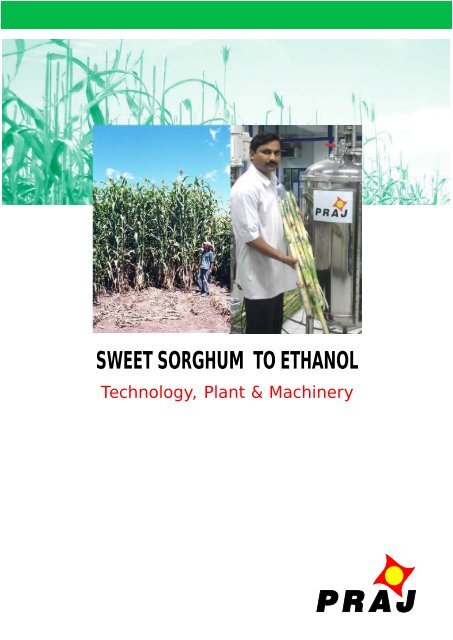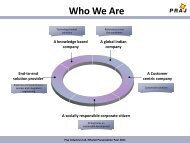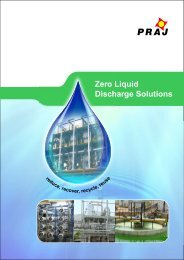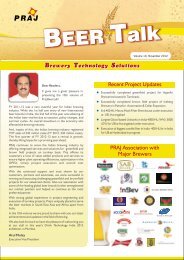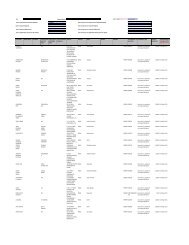SWEET SORGHUM TO ETHANOL - PRAJ Industries Ltd.
SWEET SORGHUM TO ETHANOL - PRAJ Industries Ltd.
SWEET SORGHUM TO ETHANOL - PRAJ Industries Ltd.
Create successful ePaper yourself
Turn your PDF publications into a flip-book with our unique Google optimized e-Paper software.
<strong>SWEET</strong> <strong>SORGHUM</strong> <strong>TO</strong> <strong>ETHANOL</strong>Technology, Plant & Machinery
Conventionally, Ethanol has been produced from sugarbearing feedstocks like cane/beet juice and molasses orfrom starch based feedstocks like wheat, corn or eventubers like cassava.Application of alcohol as transport fuel has created a needfor newer energy feedstocks.Praj undertook a programme for introduction of one suchfeedstock, namely Sweet Sorghum. The driving factors inthe selection of such a feedstock was,Relatively low water requirement for cultivation andprocessingWider adaptabilityHigh yieldsCo-product possibility.Sweet Sorghum as a new feedstock for bioethanol:<strong>PRAJ</strong>, through its Development Center (Matrix- theInnovation Center), conducted studies and evaluatedoptions for optimizing sweet sorghum based alcoholproduction. This effort was conducted in two phases: Agricultural trials and studies for evaluatingsuitability, technical feasibility and commercialviability of using various sweet sorghum varieties asdirect feedstock for alcohol, either singly or incombination.Experimentation, trials and scale-up of viable processtechnology for industrial scale alcohol production.Merits of Sweet Sorghum as feedstock forbioethanol production:Unlike grain Sorghum, Sweet sorghum or “Sorgo” or“kadwal” stalks are taller and juicier and have high sugarcontent, similar to sugarcane. Conventionally, somesweet sorghum varieties are grown for syrup production,while others are grown for forage.The stem juice of sweet sorghum is rich in fermentablesugar and is useful for alcohol productionAfter study, Praj established following advantages ofusing sweet sorghum for alcohol manufacturing.1. Can be uniformly grown in warm, sunny weather.2. The crop is a known to farmers.3. Harvesting & cultivation practices are easier and areidentical to sugar cane.4. Sweet sorghum requires less water and fertilizerscompared to sugarcane.5. Crop cycle is short- 3.5 to 4 months. Usually, twocycles are possible from same piece of land annually,provided irrigation is possible.6. Sweet Sorghum, on crushing to extract juice, givesbagasse as co-product which can be a principal sourceof energy for operation of distillery in the form ofboiler fuel. This practically makes alcohol productionfree of energy cost and improves possibility ofoperation in remote areas.Table : Comparison of Sweet Sorghum with Sugarcane.Parameters Sugar Cane Sweet SorghumHarvesting Cycle 9-14 Months 4 MonthsNo of cycle in a year One TwoWater Requirement 100% 65- 70%Fertilizer requirement 100% 35 -40%Stalks production,MT/Hectare/Cycle65 to 80 42 to 55 for one cycle /year84 to 110 for two cycles/ yearFermentable sugars10.0 to 14.0 9.0 -12.0concentration in stalk(% w/w)Yield of fermentable sugar,MT/Hectare/Cycle6.0 to 10.5 3.6 to 6.2 for one cycle / year7.2 to 12 .4 for two cycles / yearEthanol (100% basis) yield 3400 to 6000 2020 to 3500 for one cycle /yearlits/Hectare /cycle4000 to 7000 for two cycles / yearBagasse MT/Hectare/cycle50% w/w moisture19 to24(30% on cane weight)10 to 14 for one cycle / year(25% on stalk)20 to 28 for two cycles /year
Distilleries can be designed to operate on sweet sorghumbetween 6 to 10 months a year. Where cultivation seasonis 6-8 months, distilleries would require additionalfeedstock such as sweet sorghum syrup or sugar canemolasses or sugar cane juice or sugar beet.Accordingly, sweet sorghum can be used as feedstock foralcohol in following ways:Distilleries attached to sugar factoriesThese distilleries normally use molasses as feedstock.Actual production of molasses in these units takes placeover a period of 4 to 7 months based on sugarcanecrushing season. Molasses produced can be consumedwithin 4 to 6 months, depending on capacity of thedistillery. Sweet sorghum can be cultivated and processedfor alcohol during the additional, non-crushing season.Cane-sugar factory machinery can be used withmodifications for processing sweet sorghum.Bagasse produced can be used as fuel for generation ofsteam and electricity for operation of the distillery. Ifsweet sorghum is to be used for extended period, thenseparate pretreatment section (independent of sugarfactory) has to be installed.to 8 months, standalone distilleries can use sweetsorghum as major feedstock. Standalone distilleries needto install preprocessing machinery designed to extractjuice from sweet sorghum and for its clarification /evaporation.Wastewater from the distillery can be composted usingpress mud produced from clarification of juice. There isalso the possibility of excess electricity (co-generation)generation for commercial sale. These factors reduce costof production of alcohol.<strong>PRAJ</strong> Technology and plant design for sweet sorghumbased in distilleries:Low power consuming machinery for pretreatmentsection of new projects. Possibility of co-generation ofelectricity using bagasse to produce steam at highpressure.Low wastewater generation 2 to 3 liters / liter ofalcohol. The wastewater can be composted usingpress mud.Negligible requirement of process water for distilleryoperationsorghum.complete reuse of water from sweetExisting or proposed standalone distilleriesIn regions where favourable climatic conditions allowsweet sorghum cultivation and harvesting for more than 7
Praj Technology for Alcohol production from Sweet Sorghum.Sweet Sorghum Harvesting& Transportation of stems.BiochemicalsBiochemical ExtractiveHydrolysis/MillingHigh efficiency sugar extractioninto juiceLow Energy Consumption.BagasseCondensateJuice TreatmentClarification and partial EvaporationPress MudHIFERM ContinuousFermentationCo2Spent WashECOFINE MultipressureDistillationRectified Spirit/Neutral SpiritECOMOL Molecular SieveDehydrationFuelEthanolSteam &ElectricityBoiler &TurbineBio-CompostingOrganicFertilizererEnergy:Water-effluentIntegration and recycleSurplusElectricityMatrix - The Innovation Center at Pune.Network - InternationalNorth America, Latin America & Caribbeans: <strong>PRAJ</strong> Schneider INC., 5634 South 85th Circle, Omaha Nebraska 68127-4131Tel.: +1-402 331 7230 Fax: +1-402 331 7355 E-mail : cschneid@cjsengineering.comEurope: BioCnergy Europa B.V., (an Aker Kvaerner-Praj Company)Boris Pasternaklaan, PO Box 5270, 2701 GC Zotermeer,The Netherlands.Tel.: +31(0)793638150 Fax: +31(0)793638170 E-mail: info@biocnergy.comSouth Africa: Tel.: +27(011) 8838297 E-mail: Praj.joburg@mweb.co.zaThailand: Tel: +66 2 6553346 Fax: +66 2 6553347 E-mail: samratbose@prajfareast.comUAE: Tel: +971.6.5263371 Fax: +971.6.5557302 E-mail: Praj_mna@eim.aeNetwork - IndiaHQ: Praj <strong>Industries</strong> Limited, Praj House, Bavdhan, Pune 411 021. INDIA.Email: info@praj.net Website: www.praj.netBangalore - Email: prajblr@vsnl.net Delhi - Email: prajdel@bol.net.in


